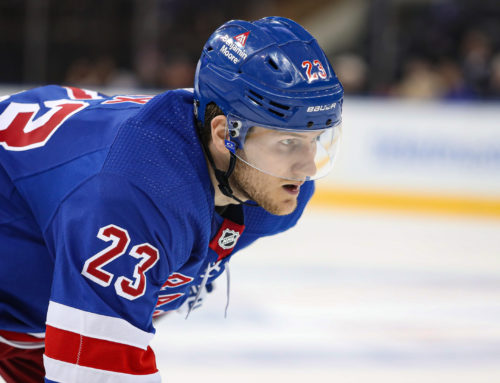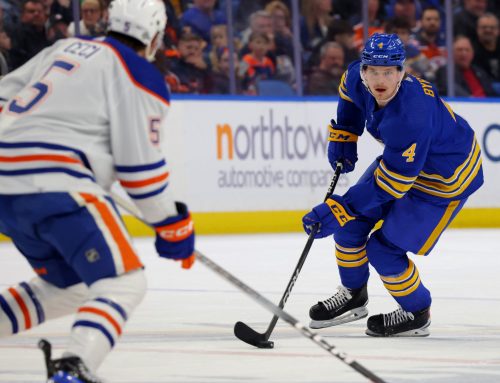
The Habs knocked one RFA off the board by signing winger Joel Armia for two more years with an AAV of $2.6M.
Armia is coming off a career year of sorts with a single-season high in goals (13) and ice time per game (15:48). There’s no fantasy relevance here. We can all move along.
*
Add Artturi Lehkonen to that list of signed RFAs. Two more years at $2.4M. He’s a guy I had hopes for in the fantasy game but it looks like he’s kind of settling into more of a checking/grinding-type role. I still think he can pop 20 goals a season but the upside may not be there anymore.
*
In case anyone was worried, Kaapo Kakko officially signed his ELC on Thursday. So, pitchforks down, everyone.
*
Normally, I like to take July mostly off from hockey (outside of my Dobber duties, of course). After free agency, my process over the last several years has been to generally avoid hockey, and fantasy hockey, until after the August long weekend. It’s just to take a break from the daily grind that lasts for basically nine months.
This summer, I’m doing things a bit differently and used the MLB All-Star break to get a head start on my projections for 2019-20. I thought it’d be fun to go over some very early projections.
A few things to keep in mind:
- There are still no draftees or other first-year players in my data
- There are a lot of adjustments yet to come, be it age, team change, injury, and other things of that sort
- No goalies
- I’m going to try and introduce new variables into my (very simplistic) model, like shot assists, and those haven’t been incorporated yet
- These are assuming everyone plays 82 games
In short, things are going to look a lot different when my projections are actually finished, whenever that is. All the same, it’s the middle of July and hockey news is sparse. At the least, maybe we can talk about our views on some players for the upcoming season? Let’s dig in.
For anyone who has been reading Dobber Hockey for at least a year, you’ll remember I was very high on Keller last season. My ranking had him as the LW12, between Jeff Skinner and Matthew Tkachuk. That, uh… let’s say that didn’t work out “well”.
Part of my analysis for young players like Keller – he’s still just 20 years old – are historical comparisons and here are a few for Keller, based on points per game, for players just finishing their age-20 season: David Pastrnak, William Nylander, Sebastian Aho, Jeff Skinner, Nathan MacKinnon, Filip Forsberg, Jason Spezza, Alex Kovalev, Nikolaj Ehlers, and Matthew Tkachuk. Even ignoring the centres, that’s a pretty distinguished list.
Now, there are different types of players in there – goal scorers, playmakers, grinder-types – but it gives you an idea why, apparently, I’m going to be high on Keller again this year.
A caveat: I’m very nervous about this. The more I dig into Keller’s two seasons, the more I see a player who doesn’t excel at anything. The entry/exit numbers aren’t elite, the shot assist numbers aren’t either (rate at which passes lead to shots), and the play-driving numbers are, at best, average.
Now, this is still a very young player, but there are worries here (we haven’t even talked about the offensive quality of the team), and a lot of his projection right now is tied into one great rookie season. Is this the season he takes a leap, or just more of the same? I’m very much hoping for the former.
Right now, my projections for him are very lofty and I can guess why:
- He’s the only defenceman post-2013 lockout to average 40+ point seasons for his age 19-21 campaigns
- He’s one of six defencemen to manage at least 10 goals, 20 assists, and two shots per game in each of the last three seasons, and he’s by far the youngest to do so
- He’s my presumptive pick to run the top PP unit
This is another projection over which I’m nervous.
Typically, young d-men aren’t the most valuable. One reason is coaches tend to lean on older players for ice time unless the young player is exceptional. This affects fantasy hockey and is one reason why Morgan Rielly was the only top-10 defenceman in Yahoo! standard leagues last year under the age of 25. In fact, there were only three defencemen in the top-24 d-men under the age of 25: Rielly, Pulock, and Nurse, and the youngest of them was 23.
What gives me hope is that it’s not like Werenski is stuck behind a stockpile of veteran defencemen. He’s easily the best left-shot defenceman on their roster and should see ice time as such. The questions belong to things like the team’s PP efficiency, his TOI on that PP, and how much the loss of Artemi Panarin affects them offensively.
Werenski should get a lot of ice time and he has very strong underlying offensive metrics. His fantasy season will come down to PP usage and efficacy. All the same, I’ll be very much intrigued by his ADP because this seems like a strong buying opportunity.
This is a wild, wild projection.
Kase’s real breakout came in 2017-18 when he had 20 goals and 38 points in 66 games playing under 14 minutes a night. He has 73 points in 149 career games, about a 40-point pace/82 games. On the surface, there’s not much exceptional here.
One big concern for Kase has long been his role on the team. With Corey Perry around the last three years, even when Kase was healthy, there was always a roadblock. That was both at even strength and on the power play. Jakob Silfverberg, too, but he’s more used as a checker so that’s not as much of a concern. Perry is gone now, though, and should mean a lot more ice time for Kase at all strengths.
Also, though Kase’s lack of production appears like a concern, his rate stats are unbelievably good. For example, over the last three years, Kase is tied with the following players in primary points/60 minutes at 5v5 (goals and first assists): Brayden Point, Mathew Barzal, and Viktor Arvidsson. Just above him his John Tavares, and just below him are Nathan MacKinnon and Jeff Skinner. That seems like good company!
It’s not a mirage, either. Kase’s entry/exit numbers are among the best in the league over the last three seasons:
.png)
All – and I mean all – his underlying numbers are very strong aside from shot assists, and even those aren’t bad, they’re just average. Poolies looking for a dark horse player with a chance at 30 goals? This is the guy.
This is a pretty interesting name heading into 2019-20. He’s had one great year and three good years, for those playing in peripheral leagues. He lost a third of last season because of a broken ankle and with the influx of talent, he eventually his power play role as well. At least to the degree it had been.
Trocheck isn’t a player who needs 20 power play points to be relevant in the fantasy game. He does enough across the board that he’ll be valuable even if he has a season where he posts 40 points. What makes him a potentially elite option, though, is those peripherals in conjunction with a 70-point season like he had a couple years ago.
I have doubts he’ll reach those highs again but he should still flirt with 20 minutes a game, and doing so on a team with talented wingers should put him firmly in the crosshairs of fantasy owners.
Even though he lost over a minute per game of PPTOI and had to return mid-season following a horrific injury, he still played to a 50-point pace per 82 games. Again, with all the talent the Panthers have, there shouldn’t be much concern he can do that over a full year. Let’s hope there’s a discount at the draft table.
Last year was undoubtedly a down year for Benn and I wrote about this extensively last month. I recommend readers checking that out.
Unsurprisingly, when I accounted for less TOI with Tyler Seguin and Alex Radulov in my projections, Benn’s didn’t look great. Not bad by any stretch – a shade over 60 points – but not close to what we have normally expected from him.
As mentioned at the beginning, however, there are adjustments yet to come. One of them is age and the other is team additions. Benn’s age will certainly dock his projections even further, but then there’s the signing of Joe Pavelski. Does that help balance things out, or does Pavelski’s own age-related decline factor in heavily? I just don’t know yet.
Regardless, Benn’s draft position is going to be much debated over the coming months and I thought I’d get the ball rolling here.
Well. Well well well.
Guys Pettersson’s age just don’t do what he did in 2018-19. Not normally. Here is a list of 20-year old rookies to manage at least 0.35 goals per game and 0.5 assists per game in the last 25 years: Alex Ovechkin, Evgeni Malkin, Elias Pettersson. That’s it. That’s the whole list.
When we include all players in their age-20 season, not just rookies, we add Connor McDavid, Steven Stamkos, Anze Kopitar, Patrice Bergeron, and Ilya Kovalchuk to the list. It is quite bonkers.
So, naturally, when I run a projection based off one season using historical comparables, his projection is off-the-charts insane for a guy his age (over a point-per-game).
I got burned by Keller last year for this exact reason but Pettersson just seems a whole other level. There were some analytical-types hyping Pettersson as the Next Big Thing before 2018-19 and that certainly came to fruition. Not to say other people weren’t high on him, but according to ADP data last year, he was routinely drafted outside the top-150, sometimes outside the top-200. That’s the public not being nearly as high on him as others were.
And now the Canucks appear to be making a big push for the playoffs and Pettersson will (likely) add J.T. Miller to his wing. All of a sudden, it doesn’t seem so preposterous that he’s well over a point-per-game player in 2019-20. I’ll be excited to post his final projection once I’m actually done because he could be the highest-ranked 21-year old I’ve had outside of the generational guys like Connor McDavid.





 FLA
FLA CHI
CHI NYR
NYR PIT
PIT L.A
L.A COL
COL MTL
MTL ANA
ANA STL
STL N.J
N.J VAN
VAN PHI
PHI
